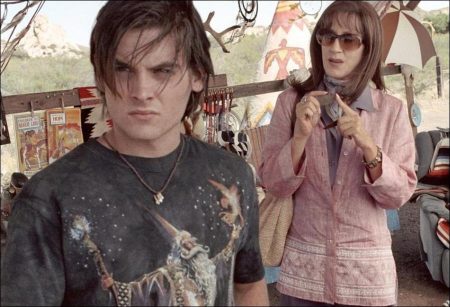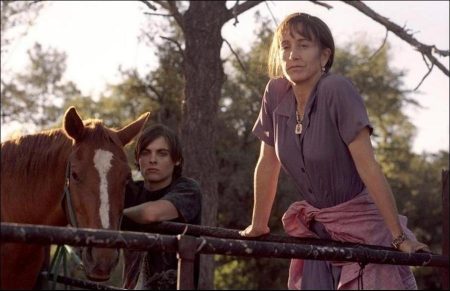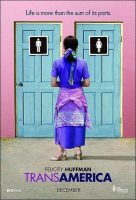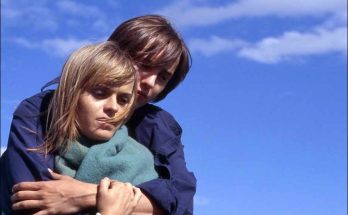Tagline: Life is more than the sum of its parts.
Transamerica tells the story of Bree (Felicity Huffman), a conservative transsexual woman who takes an unexpected journey when she learns that when she was a he, she fathered a son (Kevin Zegers), now a teenage runaway hustling on the streets of New York.
Bree is a highly educated, conservative, transsexual woman who passes as a G.G. (a genetic girl), living in a poor section of Los Angeles and working two jobs to save money for her final sexual reassignment surgery.
When she receives a phone call from Toby, a jailed teenage runaway looking for his father, she’s shocked to discover that a heterosexual encounter during her life as a man resulted in a son. Bree wants no part of Toby, but her therapist insists she must confront her past, and withholds legal permission for Bree’s final operation until she has met the boy.
Bree grudgingly dips into her precious operation fund and flies to New York to bail Toby out of jail. Released to her without explanation, Toby assumes from Bree’s conservative appearance that she’s a Christian missionary who rescues street people and converts them to Jesus. Not ready for parenthood, Bree seizes her chance and encourages Toby’s misconception.
When she learns that the rebellious, disheveled Toby intends to skip bail and hitchhike to L.A. to break into X-rated videos and search for his real father, Bree panics. She doesn’t want him to interfere with her plans for a safe, quiet new life. She offers him a ride cross-country, secretly plotting to abandon him with the stepfather he ran away from. As each lies to and manipulates the other, Bree and Toby find themselves on an unexpected and transformative journey – Transamerica.
Director’s Statement
Transamerica tells a story that is both universal and revolutionary. It’s strange how we all want the same things – family, love, home – and yet there’s no such thing as “normal”. The main character in Transamerica is transsexual, yet the film is not about transsexuality. At heart it’s an old-fashioned story about a parent, a child, and the bonds of family. The plot is structured along the familiar lines of classic American road movies, yet the two protagonists whose lives it celebrates are anything but familiar. My hope is that Transamerica will transport viewers into the minds and hearts of two human beings they might ordinarily look upon as outsiders, or more likely, not look upon at all.
Several years ago I got to know a lovely woman who told me, some months into our friendship, that she was a pre-op transsexual. She’d had electrolysis, facial feminization surgery, years of hormone therapy — everything but the final genital operation. Until she outed herself, I’d had no idea she wasn’t a biological female. Her life had been incredibly difficult. She struggled constantly with loneliness, the pain of her past and an uncertain future. Yet for every heart-breaking story she told me, there was an improbably funny one. More than anything my friend wanted “a normal life.” I was moved by her courage and her humor. I wondered whether her dream would remain forever beyond her grasp.
As the story of Transamerica evolved, I met and talked extensively with many other transwomen. Sometimes I saw unappeasable anger. More often I saw great resilience and beauty of spirit. A surprising number of the transwomen I met lived “deep stealth”, which is to say as genetic women, unrecognizable as anything other than female.
While researching Transamerica I also interviewed several street hustlers. They were damaged kids, guarded, hidden. Most of them had been abused as children. They confused sex and affection, and suspected that physical appeal was the only measure of their worth. This is why Toby comes to Bree’s bed, when out of empathy and loneliness he tries to give her the only gift he thinks he has to offer. Most people find this scene uncomfortable – as they should. Like the boys I met, Toby suffers from terrible selfimage problems. He toys with dangerous drugs. He finds it difficult to relate to adults in a non-sexual way. He’s angry, suspicious, eager-to-please, hungry for attention, seductive, highly sexual, and just a kid.
As Dr. Spikowsky tells Bree early in Transamerica, Gender Dysphoria (AKA Gender Identity Disorder, or GID) is listed in the Diagnostic and Statistical Manual of Mental Disorders endorsed by the American Psychiatric Assosiation. This listing has had the dual effect of giving transsexualism legitimacy – there’s a medical diagnosis for it – and of stigmatizing transsexuals as mentally ill. I believe transsexuality is a biological rather than psychological state. I believe that transsexuality is NOT a mental disorder, though it’s clear that growing up transsexual in a society that shuns transsexuality causes great emotional distress. – Duncan Tucker
About the Making of Transamerica
“Would Bree watch Desperate Housewives? Yes, she would love it and throw Desperate Housewives parties. She mighteven consider going blonde.” — Felicity Huffman
Felicity Huffman, who learned about Tucker’s offer for her to star in Transamerica while she was at the first table read for the “Desperate Housewives” pilot says, “Duncan told me, ‘it’s not a movie about what’s under your skirt.’”
“The film draws its life and soul from the people whose story it tells,” says Tucker. “I chose to make it a road movie because I wanted to show these two extraordinary characters against a backdrop of ordinary America and Americans. Bree and Toby unwittingly pioneer new territory in their own lives as they travel from the Northeast to the Southwest, and the sweep and scope of the landscape they pass through mirror their interior journeys. It’s impossible to write a screenplay like this without honoring the tension implicit in the characters and situation. But Bree and Toby remain spirited, hopeful people. I tried to make their story swift-paced and funny, with a lively sense of adventure and of possibility.”
As a road movie, the makers of Transamerica were able to offer their cast and crew the rare luxury of shooting the film more or less in sequence. But shooting in rural and “red state” America, the producers were a bit concerned that the film’s subject matter would get them into trouble. Producer Sebastian Dungan recalls instructing the crew, if asked by locals, to say the film was about a woman and her son going on a cross-country road trip.
“Not exactly a lie, but not the whole truth either,” Dungan recalls. “Like many lowbudget films, we often had to rely on the hospitality of local churches and community centers who rent their facilities as inexpensive holding areas near sets. I remember being particularly nervous about one such holding, a Mormon church in the middle of Nowhere, Arizona, that was down the road from where we shot the Sammy’s Wigwam sequence where Toby confronts Bree about having a penis. Locations posted signs to respect the church – “no cussing, no smoking” one read – but I was nervous that our rowdy New York crew would forget where they were. At one point, I walked in on some crew members having fun with one of the prosthetic penises that we were prepping for an upcoming scene. There was an image of Jesus on the wall. I had to break up the fun.”
Recalls Huffman, “The film started shooting in New York which was wonderful since I got to be in the city again. As a young actor I always dreamed of actually filming a movie in New York. Since I am a member of the Atlantic Theater Company I cajoled several of the members to come down and watch the first couple days of shooting, just to make sure I wasn’t too far off in left field or completely full of shit. Then we went to upstate New York, which was beautiful and made me miss the East Coast. We flew to Phoenix, which was the honeymoon of the project for me.”
“It worked out well that as Felicity and Kevin got to know each other better, so did Bree and Toby,” says Tucker. “Halfway through the production, we moved out to Arizona, where the country feels enormous and the skies are always blue. It was fun to be in those beautiful locations – the high desert outside of Chino Valley, Watson Lake in the Granite Dells, a beautiful ranch nestled in the boulders outside of Prescott, white bluffs in Skull Valley on the old Senator Highway. Everyone started having a really good time on the set. We shot what we call Bree’s and Toby’s ‘honeymoon scenes’ there, the sequence of their trip where they really start to enjoy each other.”
Those “honeymoon scenes,” and the scenes leading up to the film’s dénouement, in which Toby discovers Bree’s true identity, required Huffman and Kevin Zegers to create a tricky and transparently honest dynamic between them. As Dungan puts it, “Toby and Bree could not be more different characters. She is conservative, verbal, extremely body conscious. He is wild, exhibitionistic, and insecure about his intelligence. Both are loners, with a suspicion of a world that has abused and stigmatized them. Both have retreated and closed themselves off rather than get burned again. The tension between their differences and their similarities and the compromises the story leads them to make is the core of their journey.”
Transamerica (2005)
Directed by: Duncan Tucker
Starring: Felicity Huffman, Kevin Zegers, Fionnula Flanagan, Graham Greene, Elizabeth Pena, Craig Bockhorn, Paul Borghese, Venida Evans, Raynor Scheine, Stella Maeve, Teala Dunn
Screenplay by: Duncan Tucker
Production Design by: Mark White
Cinematography by: Stephen Kazmierski
Film Editing by: Pam Wise
Costume Design by: Danny Glicker
Set Decoration by: Lisa Scoppa
Music by: David Mansfield
MPAA Rating: R for sexual content, nudity, language and drug use.
Distributed by: The Weinstein Company
Release Date: December 2, 2005
Views: 61





